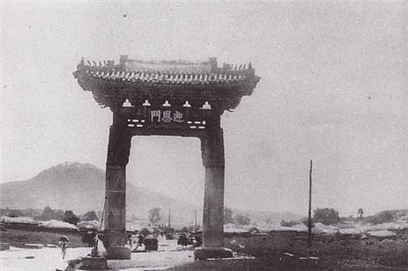서울 영은문 주초
| 서울 영은문 주초 Plinths of Yeongeunmun Gate, Seoul |
|
 서울 영은문 주초, 국가문화유산포털, 문화재청. |
|
| 대표명칭 | 서울 영은문 주초 |
|---|---|
| 영문명칭 | Plinths of Yeongeunmun Gate, Seoul |
| 한자 | 서울 迎恩門 柱礎 |
| 주소 | 서울특별시 서대문구 현저동 945번지 |
| 지정(등록) 종목 | 사적 제33호 |
| 지정(등록)일 | 1963년 1월 21일 |
| 분류 | 유적건조물/인물사건/역사사건/역사사건 |
| 시대 | 조선시대 |
| 수량/면적 | 1,111㎡ |
| 웹사이트 | 서울 영은문 주초, 국가문화유산포털, 문화재청. |
해설문
국문
영은문주초는 모화관 앞에 있던 영은문의 기둥을 받쳤던 돌이다. 1895년 사대 외교의 상징인 영은문을 철거하면서 기둥을 받치고 있던 돌만 남게 되었고, 1979년 성산대로를 공사하면서 독립문과 함께 지금의 자리로 옮겨졌다.
모화관은 조선 시대에 중국 사신을 맞이하던 곳으로, 태종 7년(1407)에 모화루라는 이름으로 처음 세웠다. 세종 12년(1430)에는 이름을 모화관으로 바꾸고 그 앞에 홍살문을 세웠으며, 중종 32년(1537)에는 홍살문보다 격식을 갖춘 영조문을 만들고 그로부터 3년 뒤 이름을 영은문이라 고쳤다.
철거되기 전 영은문의 모습이 사진으로 남아 있는데, 두 개의 긴 주춧돌 위에 원기둥을 세우고 지붕을 얹었으며 지붕은 푸른색 기와로 덮고 각종 동물 모양을 조각한 잡상을 배치하였다.
영문
Plinths of Yeongeunmun Gate, Seoul
AKS
These two stone pillars were the plinths of Yeongeunmun Gate, which stood outside Mohwagwan Hall where envoys from China were welcomed before entering the royal capital of the Joseon dynasty (1392-1910).
Mohwagwan, meaning “Hall of Admiring China,” was first established in 1407. In 1430, a red-spiked gate was erected in front of the hall to denote that the hall was a hallowed place. In 1537, the red-spiked gate was replaced with a more grandiose gate, which was named Yeongeunmun, meaning “Gate of Welcoming Grace.” Atop the gate’s stone plinths were round wooden pillars, intricate roof-supporting brackets, and a hip roof with blue roof tiles and animal figurines. After the Treaty of Shimonoseki was signed in 1895 wherein China renounced its claims of suzerainty over Korea, Yeongeunmun Gate was taken down and Dongnimmun Arch was newly built upon its site as a symbol of Korea’s sovereignty.
Yeongeunmun Gate originally stood about 70 m to the southeast of the plinths’ current location. The plinths were moved in 1979 due to the construction of Seongsan-daero Avenue.
서대문구
These plinths of Yeongeunmun Gate were originally erected in front of Mohwagwan Hall. After the demolition of Yeongeunmun Gate, which symbolized the worship of the powerful, in 1895, only these plinths remain today. During the construction of Seongsan-daero Avenue in 1979, they were moved to their current location along with Dongnimmun Gate.
Mohwagwan Hall, where Chinese emissaries were received during the Joseon Dynasty, was originally built with the name of Mohwaru Hall in 1407 (7th year of King Taejong’s reign). When the hall was renamed Mohwagwan in 1430 (12th year of King Sejong’s reign), Hongsalmun Gate, a red arrow gate, was also erected in front of the hall; in 1537 (32nd year of King Jungjong’s reign), Yeongjomun Gate, which had a more formal style than Hongsalmun Gate, was built. Three years later, Yeongjomun Gate was renamed Yeongeunmun. The photo of Yeongeunmun Gate before its demolition remains, showing that the gate consisted of cylindrical pillars on the two long plinths and a blue tiled roof built with animal figures in various forms on the roof ridges.
영문 해설 내용
AKS
이 두 개의 돌기둥은 영은문의 주초였다. 영은문은 조선시대 중국 사신들을 도성 밖에서 영접하던 모화관의 문이었다.
모화관은 ‘중국을 흠모하는 곳’이라는 뜻으로, 1407년에 처음 세웠다. 1430년 모화관이 신성한 곳임을 나타내기 위해 홍살문이 세워졌고, 1537년에는 홍살문보다 격식을 갖춘 문을 세우고 ‘은혜로운 이를 맞이하는 문’이라는 뜻의 영은문이라 하였다. 주초 위에 둥근 나무 기둥을 세우고 여러 공포로 장식된 지붕을 얹었으며, 지붕 위에는 푸른색 기와와 잡상을 올렸다. 1895년 시모노세키조약으로 중국이 한국에 대한 종주권을 상실하면서, 영은문은 철거되고 그 자리에 한국의 자주독립을 상징하는 독립문이 세워졌다.
영은문은 원래 지금의 위치에서 남동쪽으로 70m 떨어진 곳에 있었다. 1979년 성산대로를 공사하면서 주초를 지금 위치로 옮기게 되었다.
